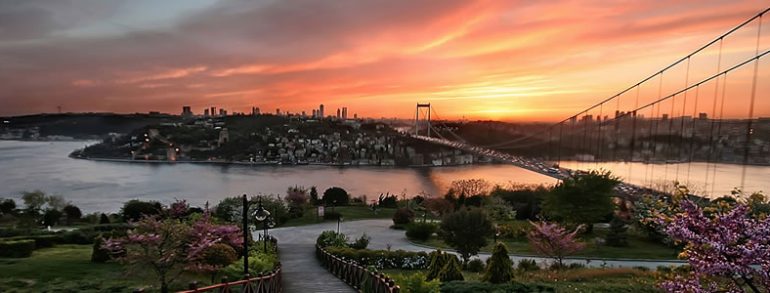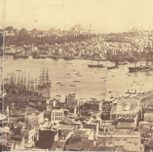Once subjected by Romans, invaded by Latin Crusaders and conquered by the Ottomans, Istanbul now hosts new conquerors equipped with the smart phones and social media, and new invaders armed with laptops, knapsacks or briefcases. What is common among these people is that they are hungry for history, and want to see historical artifacts, monuments with their own eyes. When they see the other features, such as the very modern side of Istanbul, complete with entertainment, they then understand why Istanbul has been one of the most important destinations in the world.
With its mosaic of different sounds, colors, and aromas, Istanbul is a megacity with around 14 million people, a bridge city where sun rises from Asia and sets in Europe, a capital city of the five-mega empires (Byzantine, Roman, Eastern Roman, Latin and Ottoman Empires), an exotic city with contradictory and fascinating elements of ancient-modern, Westernized-Oriental and marvelous-ordinary. Europeans recognized these exotic features and named Istanbul as the European Capital of Culture in 2010.
What makes Istanbul more valuable is that it is the only city in the world to link two continents, Asia and Europe, and a sea passing through its center. Additionally, the bay of the Golden Horn, located in the European side, makes the city such a strategic spot. Additionally, it serves as a natural harbor. These factors made this transcontinental city a meeting point of cultures and civilizations. The moderate climate of Istanbul also contributes to the comfortable year round.
With its multi-layered history, Istanbul is an open-air museum, displaying the architectural icons from the Roman classical period, and the Byzantine medieval period to the Ottoman late medieval period. It exhibits the best samples of the Art Nouveau palaces, mosques and pavilions from the late-19th and early-20th centuries. Istanbul is partially listed as a UNESCO World Heritage Site.
Istanbul retains its romantic atmosphere and its position as an important world center throughout four seasons. As momentous as Rome and as energetic as New York, the historic buildings and exciting new art galleries and museums of the city easily occupy tourists in daytime, but nighttime the megacity Istanbul turns into full action.
It is a common feeling that just before leaving Istanbul, visitors regret they did not have enough time to do this or that, and they promise themselves to return to Istanbul and enjoy it more. However, nobody leaves without buying souvenir as a remembrance of all the good moments in Istanbul.
Skyline. Without mentioning skyline and great moments, or both, a city cannot be labeled as a “great city”. Istanbul is one of them, and earned this title from its picturesque skyline. Behind the delicate minarets, distinctive domes, glamorous palaces and curvaceous exteriors built over two millenniums, the sunset in Istanbul is worth seeing.
Tulips are the symbol of both Istanbul and Turkey. The commercial cultivation of the flower first began in Istanbul during the Ottoman Empire, and it was introduced to Europe in 16th century. During the reign of Ahmed III in the Ottoman Empire, tulips symbolized the period from 1718 to 1730. The relatively peaceful period of the empire is known as the “Tulip Era”. With exotic varieties, tulips, "lale" in Turkish, can be seen in the city wherever there is any space available for planting.
Location. Istanbul is located on the 41st parallel north (latitude line), almost the same with New York (40th), Beijing (40th) Madrid (40th), Rome (41st), Chicago (41st), Seoul (37th), San Francisco (37th), Tokyo (35th), Montreal (45th), Paris (48th) and Stuttgart (48th).
Land. The area of Istanbul consists of three landmasses, two on the European side, divided by the Golden Horn, and one on the Asian side. The southern part of the city is mostly inhabited, but the northern side has dense forests. Because of its rich vegetation, the area in the north is attractive to animals and migrating birds. Together with the migrating fish through the Bosphorus, Istanbul is a great habitat for wildlife.
The Sea of Marmara, the smallest sea of the world, separates the continents of Europe and Asia in the south side of those continents. The Marmara Sea connects the Black Sea through the Bosphorus (İstanbul Boğazı) to the Aegean Sea through the Dardanelles (Çanakkale Boğazı). Because of the discrepancy in density and salt levels of waters, upper and lower currents flows in both directions in the straits. The inland sea of the Marmara was called Propontis in ancient Greek.
The Bosphorus connects the Sea of Marmara to the Black Sea, and divides Istanbul into two sides. Today, the historic and economic centers of the city is in the European side, the Asian side (Anatolian side) is mostly residential and business. The distance at the narrowest point of the 32-km-strait is 600 meters. Its depth varies from 40 to 92 meters.
Bridges. Currently, there are two bridges, built for cars and trucks only, crossing the Bosphorus, and the third bridge is in progress.The Bosphorus Bridge (Boğaziçi Köprüsü) was opened to traffic in 1973, and the distance between its towers is 1,074 m long. The Fatih Sultan Mehmet Bridge was opened to traffic in 1988, and the distance between its towers is 1,090 m long. The new Metro-Bridge, connecting Istanbul’s two historical districts between the two sides of the Golden Horn, Eminönü and Karaköy, is the new addition to the skyline of the city.
Streets. Being an ancient city comes with a ticket; Istanbul's street patterns are irregular. There are no long and straight avenues or streets in Istanbul. Therefore, there is not any easy way to navigate the city.
Transportation System. A century-old underground tram, one of the oldest in the world, shuttles between Karaköy and Istiklal Caddesi in Taksim. It runs a short distance, but the historical Tünel is symbolically important to the city. The infrastructure of the entire transport system of the city is being strengthened by a metro, tramlines, and new sea buses. The Marmaray (a trans-Bosphorus railway system) partially contributing and expanding the current system, is still in progress. The underwater section runs for 1.4 km, and the tunnel will be 13.6 km long in total when completed. There are boats of all sizes shuttling between the European and Asian sides in addition to two giant bridges on the Bosphorus. Public transport is cheap and still improving. You will not have a problem finding a taxi day or night. Licensed taxis, all metered, are yellow, with a “Taksi" sign mounted on the roof.
Art. You never feel far from art, film or music festivals in Istanbul. As the city’s young population gives those artistic events vital energy, every month a festival of some kind starts. Over 40 years, the Istanbul Foundation for Arts and Cultures has been successfully managed and promoted these events with a long roster of international big names.
Food. The major feature of Turkish cuisine is how to eat: slowly and with good company. The Turkish cuisine, based on the Mediterranean diet, is a blend of Anatolian, Central Asian, Aegean, Middle Eastern, European and North African recipes. It was also enriched by the contribution of the Palace cuisine in İstanbul. As Ottoman Turks collected and adapted the best recipes from the places they conquered, and they eliminated the more unusual flavors of these cuisines. Therefore, there is no certain dominant element in Turkish cuisine, such as spices in the Indian cuisine. With its mild taste, the Turkish cuisine is universal, tasty, and is favored by most of the foreigners. A variety of cold and warm appetizers, served in small dishes (meze, in Turkish), are important parts of the local cuisine. Made from fresh and local ingredients, a main meal will usually start with soup and meze. The main course is usually meat, chicken or fish, usually served with salad and bread. Turkish cuisine also includes a large variety of desserts. Kebab, baklava and yogurt are considered the trademark Turkish food.
Accommodation. In the historic district, now called Sultanahmet, there are several distinctive boutique hotels, ideal for those who value an authentic atmosphere. From five-star hotels to bed and breakfast lodges, the city offers a wide range of selections to its guests.
Language. The official language of the country is Turkish, and the alphabet is Latin with some additional letters, such as “ç” (ch), “ş” (sh), “ı" (like in ‘given’), “ö” (like in “sir’), and “ü” (like in ‘fuse’). English is widely spoken and understood by many in the city. German, Russian and French are also spoken especially in popular destinations, such as stores, restaurants and hotels.
Official Holidays. Like other Western countries, the weekly holidays are Saturday and Sunday. Banks, government offices and some other institutions are closed during two major Islamic Festivals, but life in the streets continues as usual.








